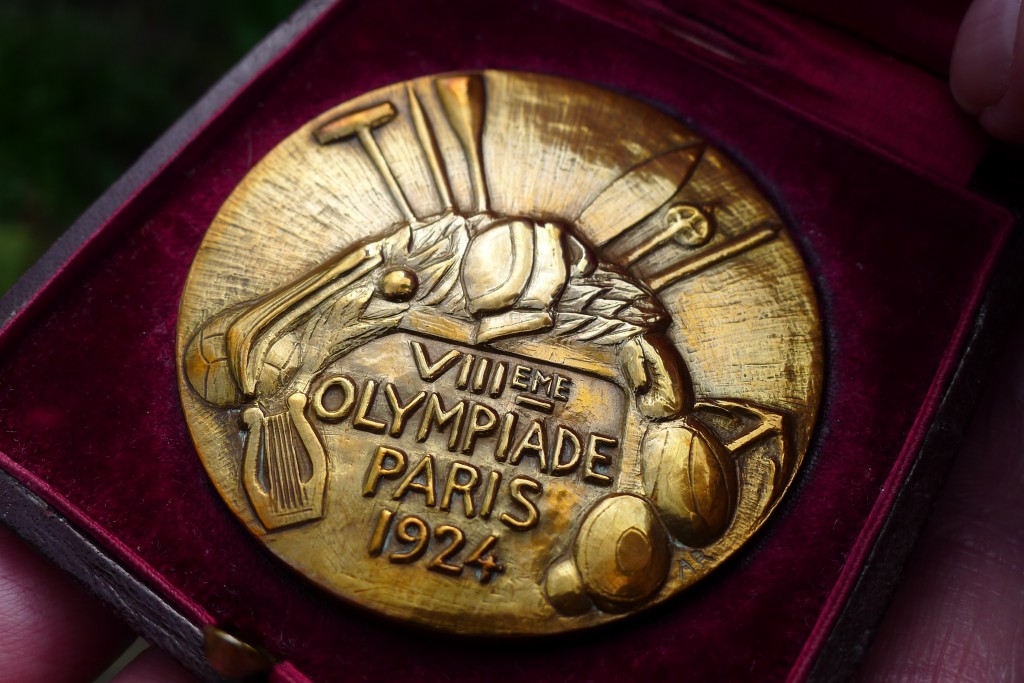“The throwing having begun, I put on a borrowed pair of shoes, the first I ever wore. I was feeling great…” -Eugene Oberst, 1924 Olympic Bronze medalist
This year marks 88 years since Eugene Oberst won a bronze medal in the javelin throw at the 1924 Olympics in Paris. Mr. Oberst was the first American to win an Olympic medal in the javelin throw. An amazing feet considering only seven Americans have medaled since. Mr. Oberst was just a young football player at Notre Dame when a stray javelin came across his path on the track field at Notre Dame. When he threw it back, a new star was born. Knute Rockne, who happened to coach both football and track and field at Notre Dame signed Oberst on the spot.

A native of Owensboro, Kentucky the young Oberst kept a journal of his time at the Olympics. Here are several excerpts from that journal shared by his son, Al Oberst of Cleveland Heights.
This of the moment he departed New York City: “At 11am we arrived at pier No. 4 Hoboken and caught our first view of the S. S. America on which we were to sail to France… At 12am we slipped anchor and steamed away from the pier. The throng gathered upon the pier gave us a roaring send off. As the tugs were pulling us out into the harbor, the whistles of other boats, bidding us a bon voyage, drowned out the sounds of bands playing on nearby boats.”
The thrill of watching the 400 meter hurdles: “The United States took first place in the 400 meter hurdles thus giving us the honor of having our flag raised above the stadium while the band struck up the Star Spangled Banner. Gee, was it was great to see our flag go up that flag pole. It made me feel a chill of joy from my feet to my head, and made me realize the wonderfulness of being an American.”
Of visiting Versailles: “Last Wednesday we took luncheon at the Ttianon Palace Hotel. I then went to the Palace of Versailles and wandered through the galleries and rooms for several hours. It contains the greatest collection of paintings that I have ever seen. . Some of the paintings are fully 80 ft. long and 30 ft. high. Practically all are all portraits and war scenes. Louis the XIV’s statue and portraits can be seen in over half of the rooms and galleries. The hall of mirrors is the beautiful but the chapel is the most beautiful creation I saw in the whole building. It of itself is with any ones time and many rooms were open to the visitors. Treasures of gold, carpets, tapestries, clocks, tables, chairs, etc, were scattered through out the buildings. Many magnificent carvings and statues of uncountable worth lend charm to the surroundings. I could spend days within the palace and still there would be things of interest that I would want to see.”

Eugene Oberst would go on to win the Bronze medal with a throw of 58.35 m. Jonni Myyrä of Finland (62.96 m) would win gold and Gunnar Lindström of Sweden (60.92 m) the silver.
Mr. Oberst went on to become a teacher, coach and athletics administrator. (1) Mr. Oberst came to Northeast Ohio to coach at John Carroll University first as a football line coach, then eventually as John Carroll’s athletic director from 1947 – 1951.

(1) http://en.wikipedia.org/wiki/Eugene_Oberst



Thanks for sharing this Heights-Olympic connection. Very cool!